In a stroke of good fortune nobody on the Cerritos College campus during the process of gathering of the injuries has suffered from an achilles tear. Some athletes on campus have suffered from strained achilles and even just minor soreness. *Knocks on wood*
Monthly Archives: April 2016
Tennis Elbow
Darryl McMillon
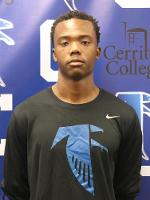
Who: Darryl McMillon
What: Tennis Elbow
When: 2014
Where: View Park High School
How: “One day I woke up and shot the ball and it just didn’t feel the same.”
Time Missed: 2 1/2 months.
Trainer’s Comments:
Shin Splints
Leslie Larranga vs. Diego Munoz
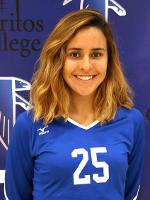
Who: Leslie Larranga
What: Shin Splints
When: 2015
Where: Cerritos College
How: “I jump a lot because I hit in the front row and one day I jumped up to hit the ball and then after I landed and continued to practice there was a pain there.”
Time Missed: 2 Weeks.
Trainer’s Comments:
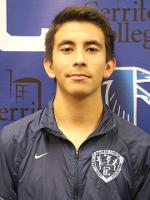
Who: Diego Munoz
What: Shin Splints
When: 2011
Where: Paramount High School
How: “I used to run a lot on cement so I guess over time it just happened like that.”
Time Missed: Still feels pain to this day.
Trainer’s Comments:
Kinesiology majors thrive on campus
According to a poll taken in Fall of 2014, 243 students at Cerritos College claimed their declared major was kinesiology.
Dean of Instructional Effectiveness Research Planning, Kristi Blackburn said that a new poll is in the works.
Kinesiology is the scientific study of human or non-human body movement. It also addresses physiological, biochemical, and psychological mechanisms.
Dean of Health Education, Dance and Athletics Dr. Dan Smith feels that number is telling of all the story.
“That is a lower number than it actually is. A lot of our students wait until they are ready to declare before choosing a major. Problem is, if they don’t declare they are not listed as kinesiology majors,” he explained.
According to Smith there is a plethora of lucrative jobs in the field of kinesiology simply because it is such a broad topic.
“A lot of people want a kinesiology degree and then apply to physical therapy school that’s a very common route. Different types of people get into medical fields and of course the traditional physical education or health education fields,” he said.
According to Smith, he does not feel that many athletes are majoring in kinesiology.
“I don’t think we have all that many athletes majoring in kinesiology, in fact I’m kind of surprised there aren’t more,” Smith said.
Kinesiology major Veronica McCaughan feels differently, being a former player herself.
“I think because in sports you have to understand your body so if you’re taking a lot of these classes you learn more about what you’re doing and how you’re doing it,” she said.
With her playing days behind her McCaughan turned her attention toward athletic training.
She feels as though every athletic trainer’s dream job is the same.
“Working for a professional team I think is every athletic trainer’s goal,” she admitted.
McCaughan was first introduced to kinesiology at a young age yet she did not know she was being introduced to it but she has received extensive help on campus from the athletic trainers.
“Brian [Cable] and Maria [Castro] help so much. They really do help you and guide you. They push you, tell you what you need and help you through it,” she said.
The college offers a multitude of different classes in order for a student to earn his or her degree.
Smith said, “Our classes are as good as any university’s, if not better. A lot of our people are in our athletic trainers aid certificate program they may also be trying to get their degree in kinesiology and get their ADT. And what they want is to transfer into one of the good athletic training [universities].”
It’s more than just kinesiology related classes at Cerritos College, students interested in the field also have a chance to learn on the job under professional athletic trainers Brian Cable and Maria Castro.
With the Cerritos College kinesiology program continuing to grow other schools are starting to take notice.
Smith said, “I just had a chair of San Bernardino tell me the other day, that one of our classes is a very strong class and he thinks so much of it that it’s a upper division class at his school. Typically, four-year universities are not going to accept one of our classes as an upper division in fact it can’t transfer.
“He said he felt so strongly about it that he did what is called a substitution. He substituted one of our classes for one of their classes there.”
Student medical staff learning on the job
The athletic training program at Cerritos College is comprised of certified athletic trainers, who teach student staff to become trainers by guiding them through procedures which provide medical services to injured athletes on campus.
The student staff team is hands-on.
Beside setting up for games and gathering water for the athletes, the staff performs other services.
The services include injury evaluation, taping, and stretching.
Veronica M’Caughan, student staff member said, “I usually start at 11 a.m. but if I come in earlier, I start as soon as I come in because there is always athletes in here.
“There is a benefit of all of us being here because we help each other, we feed off of each other.”
Student staff members are the first responders when athletes are injured.
Once they get to the injured athlete they go through a systematic and standardized procedure used to evaluate injuries called “HOPS”.
· History
· Observation
· Palpation
· Special tests
They will first gather information about how the injury occurred, use their eyes to evaluate, examine the athlete by touching and use techniques to detect what is wrong.
The student staff is not allowed to determine what happened to an athlete, but tell the certified trainers what they think the injury is.
The certified trainers, like Brian Cable and Maria Castro, will then do the evaluation again and guide the students on what they could have done to determine the injury.
Montez Hunter, student staff member explained, “They [athletes] get a little relieved after being told what was wrong or they get upset. Either way they get motivated to get back on the field.”
The first time a student staff member is allowed to touch an athlete is during the palpation process.
If the staff notices it has to do with dislocation or fractured bones they are not allowed to touch, if bones were moved it could make things worse.
The students explained how much pressure comes from dealing with an injured athlete.
If an athlete comes to the student staff for taping and the staff member doesn’t do it as well as the athlete expected, the athlete will not come back to that student.
There is also pressure on stretching an athlete before the game. If the student staff did not stretch the athlete well, they are more prone to getting injured out on the field.
“You don’t help them, you lose the player’s trust and the coaches trust,” said Hunter.
“Everything we do is pretty supervised by [Cable] and [Castro],” said M’Caughan.
According to the student staff members, Castro does the procedures and explains it, then has them do the procedure while watching them.
Cable on the other hand watches you do the procedure while coaching you on how to do it at the same time.
Spencer Knoche, student staff member said, “[Cable] and [Castro] are pretty straight forward. They both have different styles of teaching but it all depends on how you take their information.”
The student staff members were all athletes themselves. They all pursue a degree in kinesiology as their current certified trainers have a Master’s degree in that field.
Hunter expressed, “Every athletic trainers main goal when an injured athlete comes in, is to get them back on the field 100 percent.”
Cable and Castro play key role for athletes
Cerritos College athletes benefit every year from the efforts of athletic trainers.
The purpose of the trainers is the total well–being of an athlete. They spend most of their time helping those that have been hurt get back to full strength.
Services that are provided include injury evaluation, stretching, taping, and rehabilitation.
Brian Cable is one of the certified athletic trainers at the Cerritos College athletic training program.
“We take care of all of our athletes when they get injured, we give therapeutic exercise to help the athletes recover from their injury and get them back on the field,” said Cable.
The trainers work with athletes from 11 a.m. until 1 p.m. to get them ready for practice, which usually runs until about 7 p.m.
Trainers are there for athlete’s hours before the game to get the players treated and doing rehab.
Maria Castro is also a certified athletic trainer and works side by side with Cable.
Cable and Castro both have Master’s degrees in kinesiology.
Often times there are misconceptions about the profession like confusing them with personal trainers or thinking all they do is tape.
Cable and Castro have played a key role for many of the athletes whether it’s getting them back 100 percent and keeping them there.
Sophomore basketball player Ashley Flores suffered a torn medial collateral ligament during her freshman season and credits both Cable and Castro for her recovery.
“They are incredible. When I tore my MCL they helped me in rehab and pushed me to the limit in order to get better.
“Not only have they helped me with my injuries but they have helped me in many other ways as well such as stretching the right way and so forth. They are the best trainers I have ever had,” Flores said.
The rehab process was not an easy one for Flores but she was able to make it through with the help of Cable and Castro.
“They pushed me to go to rehab everyday and strengthen my leg and really worked on me. If they didn’t have me squatting, they would stretch me and have me doing several different stretches to get back my mobility,” she said.
Few ouside of the athletics program probably realize the demads that are placed on these dedicated individuals like Cable and Castro as they protect the health and rehabilitation of players, allowing them to participate in their sports.
Students in the athletic training program, also known as student staff, are doing internship hours.
Student staff member Joseph Morān said, “Being around sports is what made me join, I want to help athletes who are injured because I dealt with a lot of injuries myself.”
Cable said, “They assist us, they help us with taping, game coverage and medical coverage. They are always with us they are not allowed to be by themselves.”
Cable and Castro serve as liaisons between trainers, coaches, doctors and even parents.
Student staff, Veronica M’Caughan expressed, “I can see myself having a family like [Castro] and working at Cerritos College. She calls us her kids all the time and when she has to leave she’s like ‘Okay time to go take care of my real kids.’”
Ankle Sprain
Veronica McCaughan vs. Montez Hunter
Who: Veronica McCaughan
What: Ankle Sprain
When: 2012
Where: Eagle Rock High School
How: “So I was playing soccer and I was on a breakaway and a girl came in for a sliding tackle and she missed but I almost tripped over her so I jumped and I landed wrong.”
Time Missed: Never missed any time.
Trainer’s Comments: “It depends if its a grade I, II or III. Grade I means you tape it and try to play. Grade II means you’re typically out a week to three weeks. And grade III is anywhere from three weeks to the entire season.”
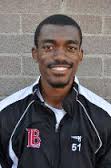
Who: Montez Hunter
What: Ankle Sprain
When: 2010
Where: Long Beach City College
How: “I was guarding this receiver and he was running a fade route, which is a deep route. The quarterback threw it and I went to jump for the ball and I stepped on his foot.”
Time Missed: Missed the entire season, almost 2 1/2 months.
Trainer’s Comments: “It depends if its a grade I, II or III. Grade I means you tape it and try to play. Grade II means you’re typically out a week to three weeks. And grade III is anywhere from three weeks to the entire season.”
Hamstring Strain
Kennedi Cooper vs. Adrian Ramirez
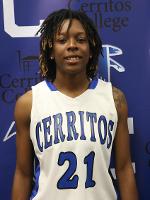
Who: Kennedi Cooper
What: Hamstring Strain
When: 2010
Where: Lakewood High School
How: “I was in a defensive stance and I guess I didn’t stretch enough and it tighten up on me.”
Time Missed: “I didn’t sit out I just played on it.”
Trainer’s Comments:
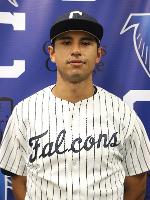
Who: Adrian Ramirez
What: Hamstring Strain
When: 2011
Where: Santiago High School
How: “I was sprinting to first base and as I lunged forward to touch the bag I felt a pull in my hamstring area and it instantly caused a lot of pain.”
Time Missed: 6 Weeks
Trainer’s Comments:
Groin Pull
Kennedi Cooper vs. Tyler Payne

Who: Kennedi Cooper
What: Groin Pull
When: 2012
Where: Lakewood High School
How: “I actually don’t remember how I even got injured.”
Time Missed: Does not remember how long she missed.
Trainer’s Comments:
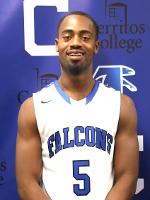
Who: Tyler Payne
What: Groin Pull
When: 2016
Where: Cerritos College
How: “I went up for a layup and my leg kind of gave out in the air as I was going up. And from then on I couldn’t stretch it out properly.”
Time Missed: “I rested a week and rehabbed with Maria Castro but I wasn’t 100 percent for another three weeks.”
Trainer’s Comments:
Concussion
Kennedi Cooper vs. Montez Hunter

Who: Kennedi Cooper
What: Concussion
When: 2015
Where: College of the Sequoias Tournament
How: “A girl set a screen on me and I ran into the girl.”
Time Missed: 2 weeks
Trainer’s Comments: “We should always follow the concussion protocol. But it depends but concussion protocol says you should sit out at least 24 hours.”

Who: Montez Hunter
What: Concussion
When: 2010
Where: Long Beach City College
How: “I was guarding a receiver and I was trailing him and when the quarterback threw the ball I went up for it and that’s all I remember.”
Time Missed: Sat out of contact drills but participated in individual drills the following the day.
Trainer’s Comments: “We should always follow the concussion protocol. But it depends but concussion protocol says you should sit out at least 24 hours.”